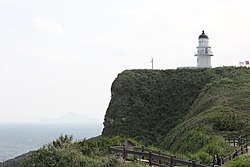Cape Santiago[1][2][a] is a cape on the easternmost point of the island of Taiwan, located in the Gongliao District, New Taipei City.
Cape Santiago
Sāndiāojiǎo | |
|---|---|
 Lighthouse at Cape Santiago | |
| Coordinates: 25°00′27″N 122°00′06″E / 25.007431°N 122.001736°E | |
| Location | Gongliao District, New Taipei City, Taiwan |
| Cape Santiago | |||||||||||
|---|---|---|---|---|---|---|---|---|---|---|---|
| Chinese | 三貂角 | ||||||||||
| |||||||||||
History
editOn 5 May 1626, a Spanish fleet reached the northeast tip of Taiwan and named the native village of Caquiunauan (also Caguiuanuan; present-day Fulong Village) as Santiago. Later this name was extended to the nearby cape.[3]
Tourist attractions
editThere is a lighthouse situated on Cape Santiago, called Cape Santiago Lighthouse. A nearby beach, Yenliao (鹽寮), was the site of the first landing for the Japanese invasion of Taiwan in 1895.
See also
editFootnotes
edit- ^ "San Diego" is found in the tourism literature but is incorrect
References
edit- ^ Andrade (2008), §12.
- ^ Davidson (1903), p. 19.
- ^ "Welcome to Taiwan Sandiaojiao (San Diego)". Eng.taiwan.net.tw. Archived from the original on 2014-05-25. Retrieved 2014-05-25.
Bibliography
edit- Andrade, Tonio (2008). "Chapter 4: La Isla Hermosa". How Taiwan Became Chinese : Dutch, Spanish and Han Colonization in the Seventeenth Century. New York: Columbia University Press. ISBN 9780231128551.
- Davidson, James W. (1903). The Island of Formosa, Past and Present : history, people, resources, and commercial prospects : tea, camphor, sugar, gold, coal, sulphur, economical plants, and other productions. London and New York: Macmillan. OL 6931635M.
External links
editWikimedia Commons has media related to Sandiao Cape.
- Northeast and Yilan Coast National Scenic Area-Taiwan (in Japanese and Chinese)
